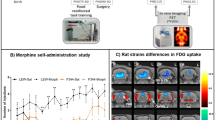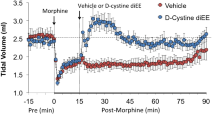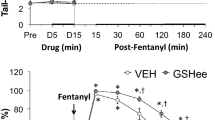Abstract
THE discovery of enkephalin has suggested one more theory to explain the mechanisms of opiate tolerance and addiction. Kosterlitz and Hughes1 proposed that a reduced enkephalin release might explain tolerance and physical dependence to opiates. Simantov and Snyder2 supported this view by showing that the content of enkephalin was changed in brain of morphine-dependent rats. Others3–5 have reported that Met-enkephalin is rapidly metabolised by brain tissue. Because of this in vivo lability of Met-enkephalin, particular precaution must be taken in the preparation of brain tissue samples for enkephalin assay. In fact, we have shown that by killing the rats with a microwave beam focused to the head and by taking particular precautions in preparing the brain samples we could measure Met-enkephalin concentrations which were higher (by several orders of magnitude) than the concentrations measured by other authors who failed to take such precautions6. Since the changes in the brain enkephalin content reported to occur either after a stress induced by foot shock7 or during morphine dependence2, were measured by a binding assay which lacks specificity for enkephalin, we decided to repeat these experiments with a technique that specifically measures Met-enkephalin6 to decide whether the brain enkephalin content changes during stress7 or opiate dependence2.
This is a preview of subscription content, access via your institution
Access options
Subscribe to this journal
Receive 51 print issues and online access
$199.00 per year
only $3.90 per issue
Buy this article
- Purchase on Springer Link
- Instant access to full article PDF
Prices may be subject to local taxes which are calculated during checkout
Similar content being viewed by others
References
Kosterlitz, H. W. & Hughes, H. Life Sci. 17, 91–96 (1975).
Simantov, R. & Snyder, S. H. Nature 262, 505–507 (1976).
Hambrook, J. M., Morgan, B. A., Rance, M. J. & Smith, C. F. C. Nature 262, 782–783 (1976).
Meeks, J. L., Yang, H.-Y. T. & Costa, E. Neuropharmacology 16, 151–154 (1977).
Marks, N., Grynbaum, A. & Neidle, A. Biochem. biophys. Res. Commun. 74, 1552–1559 (1977).
Yang, H.-Y. T., Hong, J. S. & Costa, E. Neuropharmacology 16, 303–307 (1977).
Akil, H., Madden, I. V. J., Patrick, R. L. & Barchas, J. D. in Opiates and Endogenous Opioid Peptides (ed. Kosterlitz, H. W.) (Elsevier, Amsterdam, 1976).
Guidotti, A. et al. 13, 1115–1122 (1974).
Glowinski, J. & Iversen, L. L. J. Neurochem. 13, 655–669 (1966).
Gibson, R. D. & Tingstadt, J. E. J. pharm. Sci. 59, 426–427 (1970).
Madden, I. V. J., Akil, H., Patrick, R. L. & Barchas, I. D. Nature 265, 358–360 (1977).
Author information
Authors and Affiliations
Rights and permissions
About this article
Cite this article
FRATTA, W., YANG, HY., HONG, J. et al. Stability of Met-enkephalin content in brain structures of morphine-dependent or foot shock-stressed rats. Nature 268, 452–453 (1977). https://doi.org/10.1038/268452a0
Received:
Accepted:
Issue Date:
DOI: https://doi.org/10.1038/268452a0
This article is cited by
-
The effects of morphine treatment and morphine withdrawal on the dynorphin and enkephalin systems in sprague-dawley rats
Psychopharmacology (1995)
-
Down-regulation of proopiomelanocortin synthesis and beta-endorphin utilization in hypothalamus of morphine-tolerant rats
Journal of Molecular Neuroscience (1989)
-
Opiates induce long-term increases in prodynorphin-derived peptide levels in the guinea-pig myenteric plexus
Naunyn-Schmiedeberg's Archives of Pharmacology (1986)
-
No evidence for a protracted change in endogenous opioid activity following chronic opiate treatment in mice: parallel recovery of cross tolerance to stress and morphine antinociception
Psychopharmacology (1984)
-
Opioid peptide levels in the brain and blood of rats with immobilization stress
Bulletin of Experimental Biology and Medicine (1984)
Comments
By submitting a comment you agree to abide by our Terms and Community Guidelines. If you find something abusive or that does not comply with our terms or guidelines please flag it as inappropriate.



